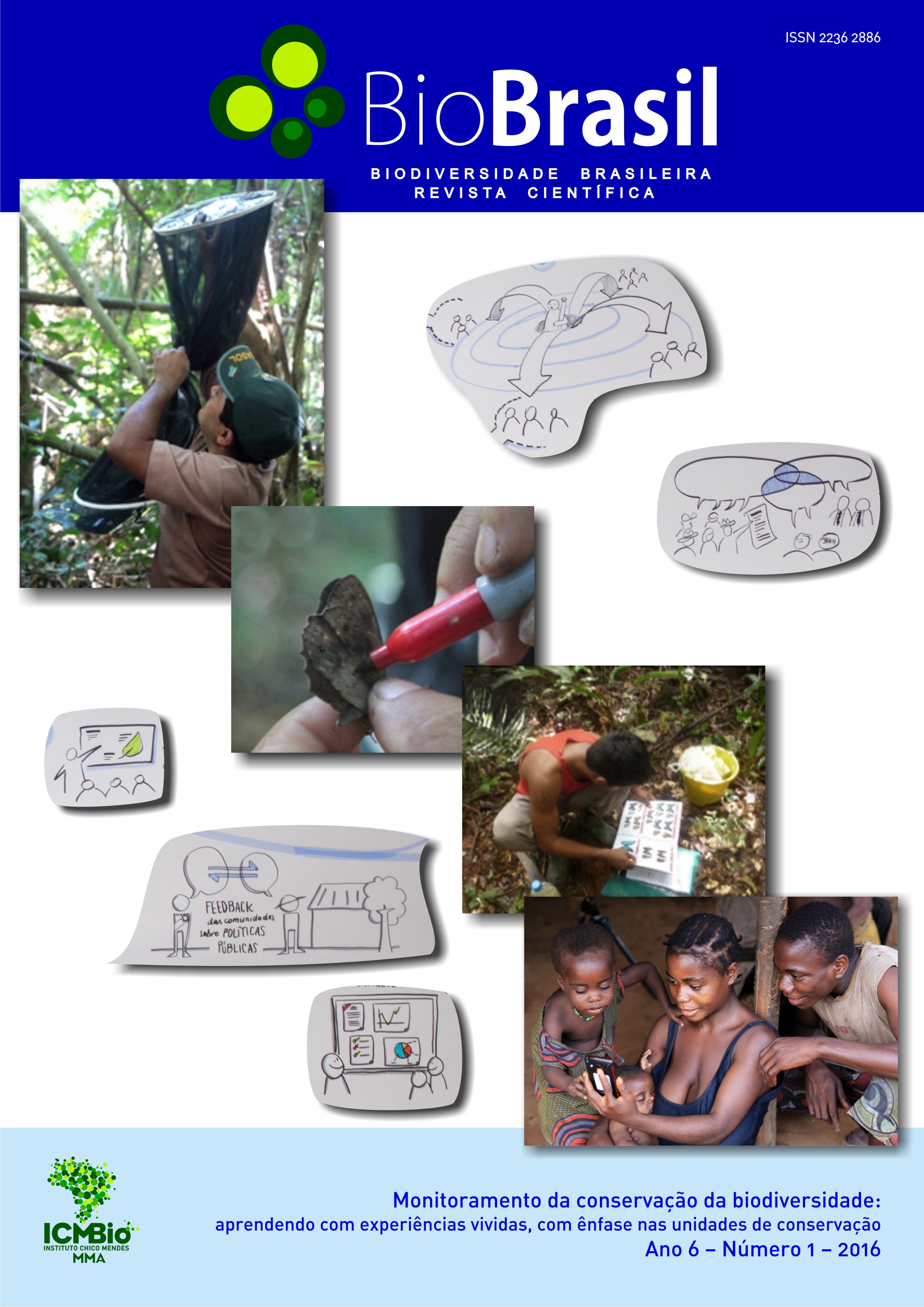Macroinvertebrados aquáticos como bioindicadores no processo de licenciamento ambiental no Brasil
DOI:
https://doi.org/10.37002/biodiversidadebrasileira.v6i1.535Keywords:
aquatic ecosystems, biomonitoring, environmental managementAbstract
In Brazil, the environmental licensing process has many stages, and it was designed as a tool to
identify the potential and to prevent environmental damages caused by enterprises. Although this procedure
is required since the mid-1980s, it is still limited regarding the use of bioassessment and biomonitoring of
aquatic ecosystems. In this process, the agency responsible for the licensing (federal, state or local) is the
responsible for defining the parameters to be measured. Those parameters are required based on the type
and magnitude of the project, and the specific environment and location proposed for its installation. We
recommend that biological responses should be used to assess and monitor stressors on aquatic ecosystems.
Macroinvertebrates have been used worldwide as bioindicators because they have some advantages over
other biological groups for this purpose. In 2011, the ‘Intersectoral Working Group on Biomonitoring' was
created to discuss the use of macroinvertebrates in biomonitoring programs. This paper presents proposals
and recommendations aiming to stimulate and provide guidance for the use of this group in the context of
the environmental licensing process in Brazil.
References
Baptista, D.F.; Buss, D.F.; Egler, M.; Giovanelli, A.; Silveira, M.P. & Nessimian, J.L. 2007. A multimetric index based on benthic macroinvertebrates for evaluation of Atlantic Forest streams at Rio de Janeiro State. Hydrobiologia, 575: 83-94.
Baptista, D.F.; Henriques-Oliveira, A.L.; Oliveira, R.B.S.; Mugnai, R.; Nessimian, J.L. & Buss, D.F. 2013. Development of a benthic multimetric index for the Serra da Bocaina bioregion in Southeast Brazil. Brazilian Journal of Biology, 73(3): 573-583.
Barbour, M.T.; Gerritsen, J.; Snyder, B.D. & Stribling, J.B. 1999. Rapid Bioassessment Protocols for use in streams and wadeable rivers: periphyton, benthic macroinvertebrates and fish. 2nd edition. EPA 841-B-99-002. US Environmental Protection Agency, Office of Water, Washington, DC.
Buss, D.F. & Borges, E.L. 2008. Application of rapid bioassessment protocols (RBP) for benthic macroinvertebrates in Brazil: comparison between sampling techniques and mesh sizes. Neotropical Entomology, 37: 288-295.
Buss, D.F. & Vitorino, A. 2010. Rapid bioassessment protocols using benthic macroinvertebrates in Brazil: evaluation of taxonomic sufficiency. Journal of the North American Benthological Society, 29: 562-571.
Buss, D.F.; Carlisle, D.M.; Chon, T.-S.; Culp, J.; Harding, J.S.; Keizer-Vlek, H.E.; Robinson, W.A.; Strachan, S.; Thirion, C. & Hughes, R.M. 2015. Stream biomonitoring using macroinvertebrates around the globe: a comparison of large-scale programs. Environmental Monitoring and Assessment, 187: 4132. DOI 10.1007/s10661-014-4132-8.
Bonada, N.; Prat, N.; Resh, V.H. & Statzner, B. 2006. Developments in aquatic insect biomonitoring: a comparative analysis of recent approaches. Annual Review of Entomology, 51: 495-523.
Clarke, R.T. & Hering, D. 2006. Errors and uncertainty in bioassessment methods - major results and conclusions from the STAR project and their applications using STARBUGS. Hydrobiologia, 566: 433-439.
Couceiro, S.R.M.; Hamada, N.; Forsberg, B.R.; Pimentel, T.P. & Luz, S.L.B. 2012. A macroinvertebrate multimetric index to evaluate the biological condition of streams in the Central Amazon region of Brazil. Ecological Indicators, 18: 118-125.
Ferreira, W.R.; Paiva, L.T. & Callisto, M. 2011. Development of a benthic multimetric index for biomonitoring of a neotropical watershed. Brazilian Journal of Biology, 71: 15-25.
Froehlich, C.G. (org.). 2007. Guia on-line: Identificação de larvas de insetos aquáticos do Estado de São Paulo. . (acesso em 22/01/2016)
Hamada, N.; Nessimian, J.L. & Querino R.B. 2014 (Eds) Insetos aquáticos na Amazônia brasileira: taxonomia, biologia e ecologia. Editora do INPA. 724p.
Heink, U. & Kowarik, I. 2010. What are indicators? On the definition of indicators in ecology and environmental planning. Ecological Indicators, 10: 584-593.
Hughes, R.M. & Peck, D.V. 2008. Acquiring data for large aquatic resource surveys: the art of compromise among science, logistics, and reality. Journal of the North American Benthological Society, 27: 837-859.
Junqueira. M.V. & Campos, M.C.S.1998. Adaptation of the BMWP Method for Water Quality Evaluation to Rio das Velhas Watershed, MG - Brazil. Acta Limnologica Brasiliensis, 10: 125-135.
Junqueira, M.V.; Friedrich, G. & Pereira de Araujo, P.R. 2010. A saprobic index for biological assessment of river water quality in Brazil (Minas Gerais and Rio de Janeiro states). Environmental Monitoring and Assessment, 163(1-4): 545-554.
Kuhlmann, M.L.; Johnscher-Fornasaro, G.; Ogura, L.L. & Imbimbo, H.R.V. 2012. Protocolo para o biomonitoramento com as comunidades bentônicas de rios e reservatórios do estado de São Paulo. São Paulo: CETESB. (acesso em 22/01/2016)
Ligeiro, R.; Ferreira, W.; Hughes, R.M. & Callisto, M. 2013. The problem of using fixed-area subsampling methods to estimate macroinvertebrate richness: a case study with Neotropical stream data. Environmental Monitoring and Assessment, 185: 4077-4085.
Macedo, D.R.; Hughes, R.M.; Ferreira, W.R.; Firmiano, K.R.; Silva, D.R.O.; Ligeiro, R.; Kaufmann, P.R. & Callisto, M. 2016. Development of a benthic macroinvertebrate multimetric index (MMI) for Neotropical Savanna headwater streams. Ecological Indicators, 64: 132-141.
Melo, A.S. 2005. Effects of taxonomic and numeric resolution on the ability to detect ecological patterns at a local scale using stream macroinvertebrates. Archiv für Hydrobiologie, 164: 309-323.
MCT, Ministério da Ciência e Tecnologia. 2006. Diretrizes e estratégias para modernização de coleções biológicas brasileiras e a consolidação de sistemas integrados de informação sobre biodiversidade. Brasília, DF.
Molozzi, J.; Feio, J.M.; Salas, F.; Marques, J.C. & Callisto, M. 2012. Development and test of a statistical model for the ecological assessment of tropical reservoirs based on benthic macroinvertebrates. Ecological Indicators, 23: 155-165.
Moreno, P.; Franca, J.S.; Ferreira, W.R.; Paz, A.D.; Monteiro, I.M. & Callisto, M. 2009. Use of the BEAST model for biomonitoring water quality in a neotropical basin. Hydrobiologia, 630: 231-242.
Monteiro, T.R.; Oliveira, L.G. & Godoy, B.S. 2008. Biomonitoramento da qualidade da água utilizando macroinvertebrados: adaptação do índice biótico BMWP Ã bacia do rio Meia Ponte-GO. Oecologia Brasiliensis, 12: 553-563.
Mugnai, R.; Oliveira, R.B.S.; Carvalho, A.L. & Baptista, D.F. 2008. Adaptation of the Indice Biotico Esteso (IBE) for water quality assessment in rivers of Serra do Mar, Rio de Janeiro State, Brazil. Tropical Zoology, 21: 57-74.
Mugnai, R.; Nessimian, J.L. & Baptista, D.F. 2010. Manual de Identificação de Macroinvertebrados Aquáticos do Estado do Rio de Janeiro: Para atividades técnicas, de ensino e treinamento em programas de avaliação da qualidade ecológica dos ecossistemas lóticos. Technical Books Editora. 176p.
Museu Paraense Emílio Goeldi, PPBio. 2012. Protocolo 6 - Invertebrados Aquáticos. (acesso em 22/01/2016)
Niemi, G.J. & McDonald, M.E. 2004. Application of ecological indicators. Annual Review of Ecology, Evolution and Systematics, 35: 89-111.
OECD, Organisation for Economic Co-Operation Development, (2003). Core Environmental Indicators. Development Measurement and Use. OECD, Paris, 37 pp.
Oliveira, R.B.S.; Mugnai, R.; Castro, C.M. & Baptista, D.F. 2011. Determining subsampling effort for the development of a rapid bioassessment protocol using benthic macroinvertebrates in streams of southeastern Brazil. Environmental Monitoring and Assessment, 175: 75-85.
Roque, F.O.; Buss, D.F.; Abes, S.S.; Stefanes, M.; Juen, L. & Siqueira, T. 2014. Insetos aquáticos no âmbito de instrumentos de gestão ambiental: caminhos ainda pouco explorados, p. 129-140. In: Hamada, N.; Nessimian, J.L. & Querino, R.B. (orgs.). Insetos Aquáticos na Amazônia brasileira: taxonomia, biologia e ecologia. Manaus: Editora do INPA.
Rosenberg, D.M. & Resh, V.H. (eds.). 1993. Freshwater Biomonitoring and Benthic Macroinvertebrates. New York: Chapman & Hall. 488p.
Sánchez, L.E. 2008. Avaliação de impacto ambiental - conceitos e métodos.
São Paulo, Oficina de Textos. 495p. São Paulo, 2013. Resolução SMA Nº 100, de 17 de outubro de 2013. Diário Oficial do Estado de São Paulo, Seção I, 123 (200) p. 41.
Schneck, F. & Melo, A.S. 2010. Reliable sample sizes for estimating similarity among macroinvertebrate assemblages in tropical streams. Annales de Limnologie - International Journal of Limnology, 46: 93-100.
Segura, M.O.; Valente-Neto F. & Fonseca-Gessner A.A. 2011. Elmidae (Coleoptera, Byrrhoidea) larvae in the state of São Paulo, Brazil: Identification key, new records and distribution. ZooKeys, 151: 53-74.
Siqueira, T.; Bini, L.M.; Roque, F.O. & Cottenie, K. 2012. A metacommunity framework for enhancing the effectiveness of biological monitoring strategies. PLoS ONE, 7: e43626. http://dx.doi.org/10.1371/journal. pone.0043626. PMid:22937068
Trivinho-Strixino, S. 2014. Ordem Diptera. Família Chironomidae. Guia de identificação de larvas, p. 457-660. In: Hamada, N.; Nessimian, J.L. & Querino, R.B. (orgs.). Insetos aquáticos na Amazônia brasileira: taxonomia, biologia e ecologia. Manaus: Editora do INPA.
Downloads
Published
Issue
Section
License
Copyright (c) 2021 Biodiversidade Brasileira - BioBrasil

This work is licensed under a Creative Commons Attribution-NonCommercial-NoDerivatives 4.0 International License.
Os artigos estão licenciados sob uma licença Creative Commons Atribuição-NãoComercial-SemDerivações 4.0 Internacional (CC BY-NC-ND 4.0). O acesso é livre e gratuito para download e leitura, ou seja, é permitido copiar e redistribuir o material em qualquer mídia ou formato.











